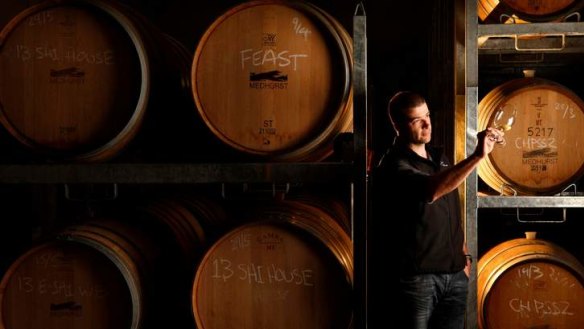Victorian winemakers celebrate top vintage
Winemakers are all smiles as a superb 2013 vintage triumphs against the odds.

To a superstitious winemaker, the 2013 vintage arrived full of portent.
Odd-numbered years are increasingly becoming the vinous equivalent of walking under a ladder or opening an umbrella in the house: something to approach with a degree of caution.
In this country, they have a history of being full of drama, of the unexpected and often the undesirable - the bushfire years of 2003, '07 and '09 on the eastern side of the country; the hard, water-stressed year of 2007; and one of the wettest, in 2011, with accompanying bouts of disease (for many).
Non-superstitious winemakers, of course, remain satisfied. Each year is undoubtedly different. Well, sometimes.
''It was warm but not hot,'' Yarra Valley winemaker Matt Steel says of the lead-up to his vintage this year.
''We didn't experience super-heat spikes. To me, the season it most resembled was 2001.''
Back in '01 - yes, an odd year - Steel was at Yarra Ridge, a member of the (then) Beringer Blass family, and making thousands of cases of Greg Norman chardonnay. The grapes stayed at a modest sugar reading of 11.5 baume - considered downright under-ripe back then - for three to four weeks never progressing further. It proved to be a testing time.
This year, Steel, now with Medhurst Wines at Gruyere, was picking chardonnay at 11.5 baume and 11.8 baume. He couldn't have been happier. With a major 360-degree shift in chardonnay style among drinkers from overripe flavours to ones of greater delicacy, he's more than pleased with what he has captured. In fact, he's musing on the possibility of blending a reserve wine from 2013, as he did in 2012.
Throughout Victoria there appear to be a lot of happy winemakers. Despite the odds, so to speak, the 2013 vintage has come out on top.
It looks set to be up there with recent star vintages 2010 and 2012.
Producers are talking it up as an excellent all-rounder year for both white and red wines.
''We couldn't be happier,'' Blue Pyrenees Estate winemaker Andrew Koerner says. ''I think we've got some of the best reds here that I have seen in the place. I've never seen such great colour in our red wines.
''Those who had water and applied it had a great year.''
Water, as ever, is the great leveller in winegrowing, especially in a potentially great year. Keeping water up to vines in the summer heat was essential.
Nine consecutive days of heat exceeding 30 degrees in March, together with the sprinkling of temperatures in the 40s, made grapes ripen day and throughout the night in the lead-up to vintage. There was no downtime for the grapes this year.
''We've never been confronted with such chronically hot conditions day and night,'' George Mihaly at Paradigm Hill on the Mornington Peninsula says.
Keeping fermenting grapes relatively cool in the heat prompted Mihaly, in an act of desperation, to squeeze his fermenting tanks into the temperature-controlled barrel room.
''It was the first time we ever had to do that,'' Mihaly says.
The heat, however, did take casualties, with Mihaly losing 60 per cent of his 2013 riesling.
At Wahgunyah in north-east Victoria, the early heat was helpful at times, thinning the crop, reducing yield and increasing quality.
''We had the cleanest [non-diseased] fruit I've ever seen,'' All Saints Estate winemaker Dan Crane says. ''The flavours were fantastic in the reds and everything is behaving itself really, really well. It has been a real winemaker vintage.''
That has translated into some potentially stunning wines.
''The reds are a world apart,'' he says. ''They are the best since '06, if not as good as '06.''
With the completion of the 2013 vintage, winemakers can now sit back and reflect on a tantalising possibility. They now appear to have two (potentially) great vintages in consecutive years. It's a mouth-watering rarity that happens maybe once or twice each decade.
In the '90s there was the glorious '90 and '91 and, depending on who you talk to, '98 and '99. Great years excite wine drinkers and makers alike because they allow a vineyard to reveal its inner worth and intrinsic beauty.
A pair of wonderful bookend vintages can't help but be the same but different. The 1990 vintage, for example, was viewed as pretty and aromatic, while '91 was about structure and concentration. How might 2012 and '13 come to be regarded?
''To me, 2012 was a strong year,'' Medhurst's Steel says. ''It has more of the things I want to see in my wines: more perfume and aromatics.''
By contrast, he sees (at this admittedly early stage) that the wines of 2013 are destined to show more weight and richness.
Tasting out of barrel, some of the early 2013 Medhurst chardonnays are already quite full in flavour.
And colour? Whereas it is possible to tell the 2011 vintage in the Yarra Valley - and other areas - by the diluted colours in the glass, there will be no such problem this year. Steel pulls out a 2013 pinot noir that is already far darker and more intense than many 2011s.
Maybe this is the year for cabernet sauvignon in the Yarra Valley, a return to prominence for the grape that started the modern Yarra Valley wine industry back in the 1960s, the one that we now overlook because pinot noir and shiraz turn our head so easily.
A great year for cabernet sauvignon - wouldn't that be nice?